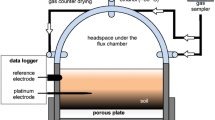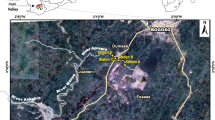Abstract
This study aimed to estimate in laboratory the temporal production of methylmercury during the filling of reservoirs of hydropower plants and to correlate it to the ecosystem of different locations in northern Brazil: Jirau hydropower plant in the Madeira River in the state of Rondônia (white waters—under construction), Cana Brava hydropower plant in the Tocantins River in the state of Goiás (clear waters—completed), and the Negro River in the Amazon (black waters—comparative). After collecting water, soil, and sediment samples in the regions mentioned, a microcosm was created to reproduce the conditions close to those found in nature. Water/soil/Hg0/Hg2+ and water/sediment/Hg0/Hg2+ were added to glass recipients. Next, methylmercury concentration was monitored by atomic fluorescence spectrometry, total organic carbon by TOC 5000A, and physical and chemical parameters such as pH, redox potential, and dissolved oxygen, for 25 days. The results obtained allow concluding that organic matter plays an important role, providing excess methyl groups to react with inorganic Hg and form organic Hg. The Negro River, which has higher contents of organic matter in its soil, water, and sediment, presented higher potential of mercury methylation in both experiments performed, followed by rivers Madeira and Tocantins.





Similar content being viewed by others
References
Akagi, H., Malm, O., Kinjo, Y., Harada, M., Branches, F. J. P., Pfeiffer, W. C., & Kato, H. (1995). Methylmercury pollution in the Amazon, Brazil. Science of The Total Environment, 175(2), 85–95.
ANNEL – National Electric Energy Agency. (2019). Power plants and generating plants - Generation Information Bank. http://www2.aneel.gov.br/scg/Consulta_Empreendimento.asp. Accessed 25 may 2019.
Bastos, M. O., & Lacerda, L. D. (2004). A contaminação por mercúrio na bacia do Rio Madeira: uma breve revisão. Geochimica Brasiliensis, 18(2), 99–114.
Bisinoti, M. C., & Jardim, W. F. (2004a). O Comportamento do metilmercúrio (MetilHg) no ambiente. Química Nova, 27(4), 593–600.
Bisinoti, M. C., & Jardim, W. F. (2004b). Productionof organic mercuryfrom Hg0: experiments using microcosms. Brazilian Chemical Society, 242(14), 244–248.
Bloom, N. S., & Effler, S. W. (1990). Seasonal variability in the mercury speciation of Onondaga Lake (New York). Water, Air, and Soil Pollution, 53(3), 251–260.
Cano, T. M. (2014). Efeitos deletérios e teratogênicos da exposição ao mercúrio - revisão da literatura. Revista da Associação Médica Brasileira, 3(3), 288–300.
Compeau, G. C., & Bartha, R. (1985). Sulfate-reducing bacteria: principal methylators of mercury in anoxic estuarine sediment. Applied and Environmental Microbiology, 50(2), 498–502.
Davidson, P. W., Myers, G. J., Cox, C., Shamlaye, C., Choisy, O., Sloane-Reeves, J., Cernchiari, E., Marsh, D. O., Berlin, M., Tanner, M., & Clarkson, T. W. (1995). Neurodevelopmental test selection, administration, and performance in the main Seychelles child development study. Neurotoxicology, 16(4), 665–676.
Edmonds, S., O’Driscoll, N., Hillier, K., Atwood, J. L., & Evers, D. (2012). Factors regulating the bioavailability of methylmercury to breeding rusty blackbirds in northeastern wetlands. Environmental Pollution, 171, 148–154.
Fadini, P. S., & Jardim, W. F. (2001). Is the Negro river basin (Amazon) impacted by naturally occurring mercury? Science of the Total Environmental, 275(3), 71–82.
Figueiredo, N. L., Canário, J., O’Driscoll, N. J., Duarte, A., & Carvalho, C. (2016). Aerobic mercury-resistant bacteria alter mercury speciation and retention in the Tagus Estuary (Portugal). Ecotoxicology and Environmental Safety, 124, 60–67.
Gibbs, R. J. (1967). The geochemistry if the Amazon river system. Part I - the factors that control the salinity and the composition and concentration of the suspended solids. Geological Society of America Bulletin, 78(10), 1203–1232.
Gilmour, C. C., Podar, M., Bullock, A. L., Graham, A. M., Brown, S. D., Somenahally, A. C., Johs, A., Hurt, R. A., Jr., Bailey, K. A., & Elias, D. A. (2013). Mercury methylation by novel microorganisms from new environments. Environmental Science & Technology, 47(20), 11810–11820.
Harada, M. (1995). Minamata Disease: Methylmercury Poisoning in Japan Caused by Environmental Pollution. Critical Reviews in Toxicology, 25(1), 1–24.
Harmon, S. M., King, J. K., Gladden, J. B., Chandler, G. T., & Newman, L. A., (2005). Mercury body burdens in Gambusia holbrooki and Erimyzon sucetta in a wetland mesocosm amended with sulfate. Chemosphere, 59(2), 227–233.
Hintelmann, H., Falter, R., Ilgen, G., & Evans, R. D. (1997). Determination of artifactual formation of monomethylmercury (CH3Hg+) in environmental samples using stable Hg2+ isotopes with ICP-MS detection: calculation of contents applying species specific isotope addition. Fresenius Journal of Analytical Chemistry, 358(3), 363–370.
Lima, E. R. Z., Colon, J. C., & Souza, M. T. (2009). Alterações auditivas em trabalhadores expostos a mercúrio. Revista CEFAC, 11(suppl 1). https://doi.org/10.1590/S1516-18462009005000003.
Macalady, J. L., Mack, E. E., Nelson, D. C., & Scow, K. M. (2000). Sediment Microbial Community Structure and Mercury Methylation in Mercury-Polluted Clear Lake, California. Applied and Environmental Microbiology, 66(4), 1479–1488.
McClain, M. E., Richey, J. E., & Brandes, J. A. (1997). Dissolved organic matter and terrestrial-lotic linkages in the central Amazon basin of Brazil. Global Biogeochemical Cycles, 11(3), 295–311.
Miranda, J. C., & Mazzoni, R. (2009). Estrutura e persistência temporal da comunidade de peixes de três riachos do Alto Rio Tocantins GO. Biota Neotropica, 9(4), 71–78.
MIretzky, P., Bisinoti, M. C., Jardim, W. F., & Rocha, J. C. (2005). Factors affeting Hg (II) adsorption in soils from the Rio Negro basin (Amazon). Quimica Nova, 28(3), 438–443.
Morel, F. M. M., Kraepiel, A. M. L., & Amyot, M. (1998). The chemical cycle and bioaccumulation of mercury. Annual Review of Ecology and Systematics, 29(1), 543–566.
Oliveira, L. C., Serudo, R. L., Botero, W. G., Mendonça, A. G. R., Santos, A., Rocha, J. C., & Carvalho Neto, F. S. (2007). Distribuição de mercúrio em diferentes solos da Bacia do Médio Rio Negro-AM: influência da matéria orgânica no ciclo biogeoquímico do mercúrio. Química Nova, 30(2), 274–280.
Olson, B. H., & Cooper, R. C. (1975). Comparison of aerobic and anaerobic methylation of mercuric chloride by San Francisco bay sediments. Water Research, 10(2), 113–116.
Salomons, W., & Forstner, V. (1984). Metals in hidrocycle. Berlin: Springer-Verlag.
Silva, L. A., & Scariot, A. (2003). Composição florística e estrutura da comunidade arbórea em uma floresta estacional decidual em afloramento calcário, Fazenda São José, São Domingos, GO, bacia do rio Paranã. Acta Botanica Brasilica, 17(2), 305–313.
Spangler, W. J., Spigarelli, J. L., Rose, J. M., & Miller, H. M. (1973). Methylmercury: bacterial degradation in lake sediments. Science, 180(4082), 192–193.
Watanabe, C. H., Monteiro, A. S. C., Gontijo, E. S. J., Lira, V. S., Bueno, C. C., Kumar, N. T., Fracácio, R., & Rosa, H. A. (2017). Toxicity assessment of arsenic and cobalto in the presence of aquatic humic substances of different molecular sizes. Ecotoxicology and Environmental Safety, 139(1–8).
Zhao, L., Chen, H., Lu, X., Lin, H., Christensen, A. G., Pierce, E. M., & Gu, B. (2017). Contrasting effects of dissolved organic matter on mercury methylation by geobacter sulfurreducens PCA and Desulfovibrio desulfuricans ND132. Environmental Science & Technology, 51(18), 1–8.
Acknowledgements
This work was supported by the São Paulo Research Foundation - FAPESP [grant numbers: 2018/18693-6] and Brazilian National Council for Scientific and Technological Development – CNPq.
Author information
Authors and Affiliations
Corresponding author
Additional information
Publisher’s Note
Springer Nature remains neutral with regard to jurisdictional claims in published maps and institutional affiliations.
Rights and permissions
About this article
Cite this article
Gomes, V.M., dos Santos, A., Zara, L.F. et al. Study on Mercury Methylation in the Amazonian Rivers in Flooded Areas for Hydroelectric Use. Water Air Soil Pollut 230, 211 (2019). https://doi.org/10.1007/s11270-019-4261-3
Received:
Accepted:
Published:
DOI: https://doi.org/10.1007/s11270-019-4261-3




